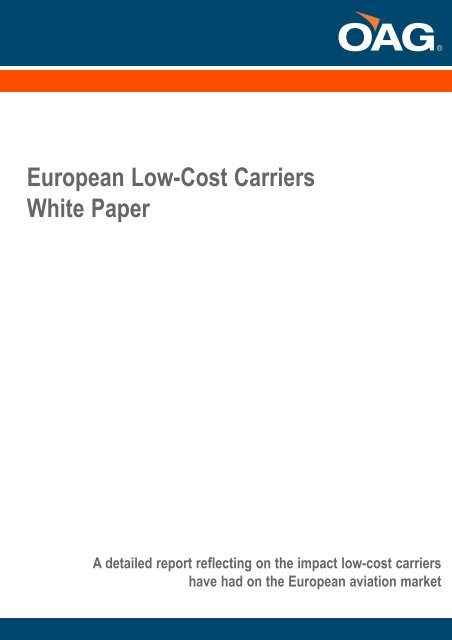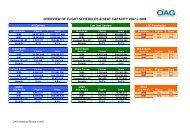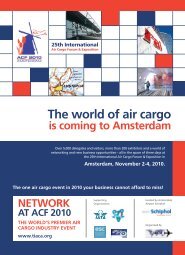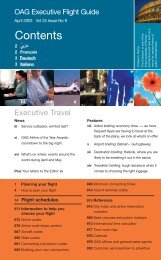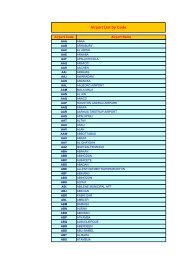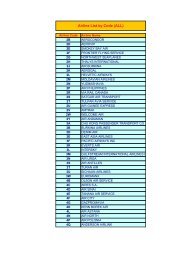European Low-Cost Carriers White Paper - Oag.com
European Low-Cost Carriers White Paper - Oag.com
European Low-Cost Carriers White Paper - Oag.com
You also want an ePaper? Increase the reach of your titles
YUMPU automatically turns print PDFs into web optimized ePapers that Google loves.
<strong>European</strong> <strong>Low</strong>-<strong>Cost</strong> <strong>Carriers</strong><br />
<strong>White</strong> <strong>Paper</strong><br />
A detailed report reflecting on the impact low-cost carriers<br />
have had on the <strong>European</strong> aviation market
The most<br />
significant<br />
achievement<br />
for the LCCs,<br />
especially in<br />
the EU, is that<br />
they have<br />
bought air<br />
travel within<br />
easy reach of<br />
everyone<br />
across Europe<br />
OAG report on <strong>European</strong> <strong>Low</strong>-cost carriers<br />
Dedicated to the late Adrian Hunt, former CEO of Deutsche BA<br />
- a good colleague, friend of OAG and contributor to this paper<br />
1. INTRODUCTION<br />
In a single decade, low-cost carriers (LCCs) have transformed the <strong>European</strong><br />
aviation scene beyond recognition. They have changed people's leisure and travel habits,<br />
opened up direct services between EU city pairs that were not available through the legacy airlines, forced<br />
established airlines and tour operators to change their business models, popularised regional airports by<br />
breathing life into otherwise under utilised airports and changed forever the image of air travel. Perhaps<br />
though, the most significant achievement for the LCCs, especially in the EU, is that they have bought air<br />
travel within easy reach of everyone across Europe. Who could have predicted, 10 years ago, that Ryanair<br />
would carry more passengers in Europe per month than British Airways?<br />
2. FREQUENCY OF FLIGHTS ON LCC vs TOTAL ON ALL CARRIERS<br />
3. SEAT CAPACITY ON LCC FLIGHTS vs TOTAL ON ALL CARRIERS<br />
<strong>European</strong> <strong>Low</strong>-<strong>Cost</strong> <strong>Carriers</strong> <strong>White</strong> <strong>Paper</strong> Page 1 March 2006
The<br />
enlargement of<br />
the EU in May<br />
2004 to<br />
include 10<br />
more nations<br />
has given<br />
LCCs renewed<br />
impetus<br />
But the story is not one of unqualified success. Several LCCs have collapsed leaving passengers with no<br />
financial protection, although the same happens with the failure of a full-service scheduled airline. LCCs are<br />
often accused of misleading advertising and poor levels of customer service, although they often out<br />
perform the legacy airlines in operating performance.<br />
The EC has forced Ryanair to repay 4 million in subsidies from Charleroi airport in Belgium, pending an<br />
appeal to the <strong>European</strong> Court of Justice. It ruled that publicly owned airports cannot subsidise airlines, but<br />
the case had features peculiar to Charleroi and Ryanair argues that the costs of setting up its base far<br />
outweighed the financial support received. With the bravado that has <strong>com</strong>e to typify the low-cost sector,<br />
Ryanair accuses the EC of double standards, allowing ailing carriers such as Alitalia to remain afloat with<br />
public money.<br />
But nothing seems to retard the spectacular progress of low-cost carriers throughout Europe. OAG<br />
identifies 40 LCCs throughout Europe, with several now expanding from their home countries. Air Berlin<br />
has a growing network in Spain and Ryanair and easyJet have both established dominant positions by<br />
opening bases throughout Europe.<br />
The enlargement of the EU in May 2004 to include 10 more nations has given LCCs renewed impetus, with<br />
many new services starting in Central and Eastern Europe as a result of the deregulation that EU<br />
membership brings. Despite a largely regulated environment, LCCs have also begun to appear in the<br />
Middle East and Africa.<br />
Although Ryanair had started operations a decade earlier from its Irish base, the LCC revolution really got<br />
underway with the creation of the single <strong>European</strong> Aviation Market which enabled Ryanair and easyJet to<br />
expand their services of low fares and high frequencies. Further expansion occurred with the growth of the<br />
Internet and developments in technology such as yield and capacity management systems which bought<br />
huge cost savings for airlines to pass on to passengers, triggering a boom in flight capacity.<br />
The low-cost model adopted by Ryanair and easyJet - based on Southwest Airlines' successful formula in<br />
the US - has been copied by most other LCCs. Elements of it - especially web booking based on variable<br />
one-way fares - are now the norm for full-service carriers, too. The key <strong>com</strong>ponents are ticketless travel,<br />
Internet booking rather than through the more costly Global Distribution Systems, no <strong>com</strong>mission for<br />
travel agents, no seat allocation or connecting flights, and "no frills" such as in-flight catering (customers<br />
pay extra for what they require), business class and lounges.<br />
That model remains essentially the same 10 years on, although Ryanair is now indicating that it could cut<br />
costs further by banning hold baggage, thus reducing loading and turnaround times even further, and<br />
introducing totally automated check-in. easyJet has also evolved from this model, building hubs at London<br />
Gatwick and introducing automated check-in and lounges etc.<br />
The airline has also pioneered services to secondary airports such as Frankfurt Hahn and Stockholm<br />
Skavsta, which may be distant from the city advertised - 120km and 88km respectively. It has attracted<br />
criticism by describing Charleroi in Belgium as "Brussels", and Gerona in Spain as "Barcelona".<br />
<strong>European</strong> <strong>Low</strong>-<strong>Cost</strong> <strong>Carriers</strong> <strong>White</strong> <strong>Paper</strong> Page 2 March 2006
The UK is the<br />
largest and<br />
most mature<br />
market for<br />
LCCs in<br />
Europe<br />
The most profitable routes for LCCs are of no more than two hours' duration, allowing maximum utilisation<br />
of aircraft. They started by flying city-to-city routes but are now increasingly targeting resorts, although<br />
many tend to ignore routes of three hours or longer. This means that major markets such as the Canary<br />
Islands are little served by LCCs, except those owned by tour operators.<br />
The UK is the largest and most mature market for LCCs in Europe, followed by Germany and Spain, which<br />
is now seeing the fastest growth. France has no major LCC of its own, for reasons which include the<br />
dominance of Ryanair, its high-speed TGV rail network and a relatively small market for Mediterranean<br />
flights <strong>com</strong>pared to the more northerly sun-seeking markets of Germany, Scandinavia and the UK.<br />
4. LOW COST CARRIERS OPERATING TO/FROM MAJOR EUROPEAN COUNTRIES<br />
BY FREQUENCY IN NOVEMBER 2005<br />
Source: OAG MAX Online. February 2006<br />
In addition to Ryanair (based in Ireland but with its biggest operations in the UK), and easyJet, LCCs based<br />
in the UK include bmibaby (part of BMI, formerly British Midland); Flybe (formerly British <strong>European</strong> and<br />
Jersey <strong>European</strong>); and start-up carriers Jet2 and Flyglobespan. Monarch Scheduled and Thompsonfly are<br />
also developing rapidly, having grown out of charter airlines.<br />
<strong>European</strong> <strong>Low</strong>-<strong>Cost</strong> <strong>Carriers</strong> <strong>White</strong> <strong>Paper</strong> Page 3 March 2006
Apart from<br />
Manchester,<br />
UK regional<br />
airports had<br />
few direct<br />
scheduled<br />
services to<br />
Europe before<br />
the LCC<br />
revolution<br />
5. LOW COST CARRIERS TO/FROM THE UK<br />
Source: OAG MAX Online. March 2006<br />
Initially, full service airlines operating from the UK did not regard LCCs as much of a threat as the LCCs<br />
were based at secondary airports - Ryanair at London Stansted, and easyJet at London Luton. Failure to<br />
examine and understand the LCC business model meant full-service airlines soon found LCCs eating into<br />
their markets and creating new business. Apart from Manchester, UK regional airports had few direct<br />
scheduled services to Europe before the LCC revolution. easyJet is now the second largest carrier at<br />
London Gatwick after British Airways.<br />
The reaction of legacy carriers on short-haul routes started with indifference until the gradual realisation that<br />
the threat was here to stay. In 1998, BA set up its own low-cost subsidiary, Go, to <strong>com</strong>pete with Ryanair.<br />
But in 2001 BA sold its fledgling to a management buy-out, only for easyJet to purchase Go a year later for<br />
a much higher price. KLM's Buzz was also relatively short-lived, launched in 2000 and sold three years later<br />
to Ryanair.<br />
BMI set up its bmibaby offshoot in 2002, but it operates from regional bases rather than London - a<br />
development plan also followed by Flybe. In 2005, however, BMI introduced "Tiny" fares and bmibaby<br />
branded promotions for its own flights from Heathrow, while introducing paid-for in-flight service and<br />
withdrawing business class on all but a few short-haul routes.<br />
It is now possible to fly from Heathrow on BMI, BA and many foreign carriers - such as Aer Lingus and<br />
Iberia - for the same or lower fares than LCCs offer from Gatwick, Stansted or Luton. Full-service benefits<br />
are still offered by most Heathrow airlines, including business class, seat selection and (possibly) free<br />
in-flight food, as still offered by BA. But capacity controls on Heathrow mean that LCCs often still offer a<br />
better deal from other UK airports, and the introduction of low fares from Heathrow has not impeded the<br />
LCCs' growth.<br />
<strong>European</strong> <strong>Low</strong>-<strong>Cost</strong> <strong>Carriers</strong> <strong>White</strong> <strong>Paper</strong> Page 4 March 2006
LCCs are now<br />
targeting<br />
resorts and<br />
eating into<br />
tour operators'<br />
market share<br />
As legacy carriers have had to adopt new business models to cope with LCCs, the same is happening to<br />
tour operators in markets such as Germany and the UK, where they play a dominant role. Having saturated<br />
most city-to-city routes, LCCs are now targeting resorts and eating into tour operators' market share.<br />
Of the four dominant tour operators in the UK, MyTravel (formerly Airtours) was the first to react to this<br />
trend by setting up its own LCC, MyTravelLite. That brand - which operated only from Birmingham - has<br />
now been scrapped due to retrenchment at cash-strapped MyTravel, but the biggest operator, Thomson<br />
(part of TUI UK) is now taking major steps.<br />
Its LCC subsidiary, Thomsonfly, started operations in 2004 from only one airport - Coventry, near<br />
Birmingham, which at that time had no other scheduled operations. For summer 2005 it added flights from<br />
Bournemouth and a new airport developed from a former military airfield, Robin Hood Doncaster Sheffield.<br />
Thomson's charter airline Britannia has now adopted Thomsonfly branding, and for summer 2006 TUI UK<br />
will operate LCC model services from 11 UK airports including Gatwick and Luton.<br />
The distinction between LCC and charter services has now be<strong>com</strong>e blurred, with predictions that UK tour<br />
operators First Choice and Thomas Cook will do something similar. Thomsonfly has followed other LCCs by<br />
making ac<strong>com</strong>modation, car hire and other ground services bookable through its website, <strong>com</strong>peting with<br />
carriers such as easyJet but effectively unpackaging its own product.<br />
A major question raised by this is the loss of financial protection. Although the EC package travel<br />
regulations require tour operators throughout the EU to protect their customers' money in the event of their<br />
failure, the same does not apply to flights, ac<strong>com</strong>modation and other elements booked separately.<br />
With most LCCs being formed by entrepreneurs rather than multi-nationals such as TUI, inevitably there<br />
have been several failures - including Air Polonia of Poland and EUJet of the UK. A survey by the UK Civil<br />
Aviation Authority found that families had to pay an average of £400 to get home after EUJet's failure in<br />
July 2005, while those yet to travel lost their money unless they had paid at least £100 by credit card, this<br />
being protected under UK law. Such protection does not exist in most <strong>European</strong> countries although it may<br />
be possible to insure against an airline's collapse.<br />
In Germany, also, tour operators have entered the LCC arena with Thomas Cook-owned Condor <strong>com</strong>peting<br />
with Air Berlin on some routes. TUI also owns German LCC Hapag-Lloyd Express although this is mainly a<br />
business carrier.<br />
<strong>European</strong> <strong>Low</strong>-<strong>Cost</strong> <strong>Carriers</strong> <strong>White</strong> <strong>Paper</strong> Page 5 March 2006
Central and<br />
Eastern<br />
Europe has<br />
been a key<br />
growth area<br />
since many of<br />
its states<br />
joined the EU<br />
in 2004<br />
6. LOW COST CARRIERS TO/FROM GERMANY<br />
Source: OAG MAX Online March 2006<br />
Full service airlines throughout Europe are being forced to react to the growing power of LCCs by adapting<br />
their business models. Iberia, for example, makes in-flight food an optional extra but plans a 17% reduction<br />
in domestic capacity for 2006-08. SAS Scandinavian Airlines operates its own LCC, Snowflake, as does<br />
LOT Polish Airlines with Centralwings.<br />
Central and Eastern Europe has been a key growth area since many of its states joined the EU in 2004 and<br />
the Czech Republic declared open skies in the 1990s, creating a huge leisure market for Prague. Ryanair<br />
and easyJet are making inroads but the dominant LCCs are Wizz Air, with bases in Hungary and Poland;<br />
and SkyEurope, operating out of Hungary, Poland and Slovakia. Bulgaria and Romania, which are due to<br />
join the EU in 2007, are also starting to see some LCC activity.<br />
The Middle East remains a largely regulated market, but LCCs are appearing as established carriers<br />
protect their markets and start-up airlines look for new opportunities. The huge movement of expatriate<br />
workers between the Indian sub-continent and the Gulf region is being targeted by Gulf Traveller, an<br />
all-economy carrier set up by Gulf Air; while Air Arabia, based in the <strong>com</strong>petitive emirate of Sharjah, claims<br />
to be the region's first LCC established in 2003.<br />
MenaJet started operations from Lebanon in 2004, targeting outbound leisure passengers; while<br />
Kuwait-based low-cost carrier Jazeera Airways started flights in November 2005 with about 30 flights per<br />
week to Amman, Bahrain, Beirut, Damascus and Dubai.<br />
In North Africa, Royal Air Maroc set up LCC subsidiary Atlas Blue in 2004 to serve the French, Italian,<br />
Belgian, Dutch, German and British markets, concentrating on the leisure destinations of Marrakesh and<br />
Agadir.<br />
<strong>European</strong> <strong>Low</strong>-<strong>Cost</strong> <strong>Carriers</strong> <strong>White</strong> <strong>Paper</strong> Page 6 March 2006
The larger<br />
LCCs have<br />
proved they<br />
can attract<br />
a totally new<br />
market while<br />
eating into the<br />
market share<br />
of legacy<br />
airlines<br />
South Africa has witnessed the arrival of LCCs Kulula and 1time, but a constraining factor here is the low<br />
ownership of credit cards <strong>com</strong>pared to Europe.<br />
Will the LCC boom continue in Europe? It seems inevitable that the growth rates of recent years will slow<br />
down, except in Central and Eastern Europe where there is still untapped potential. The larger LCCs have<br />
proved they can attract a totally new market while eating into the market share of legacy airlines and tour<br />
operators, but some consolidation is likely at the expense of smaller operators.<br />
The load factors and profitability of Ryanair and easyJet are the envy of the industry.<br />
In February 2005, Ryanair announced firm orders for a further 70 Boeing aircraft, which will increase its<br />
fleet to 225 aircraft, with 200 options pending. When it can be cheaper for someone living in northern<br />
England to fly to Europe for the weekend rather than take a train to London, LCCs will continue to flourish.<br />
Business travellers are also flying LCCs in a big way, although the lack of flexibility in most fares means a<br />
high no-show factor. The Barclaycard Business Travel Survey 2004-05 shows that 71% of UK business<br />
travellers had flown on a LCC and that 96% were very satisfied and would use one again.<br />
Will the full-service model survive on routes within short-haul Europe in the long-term? The answer is<br />
probably not.<br />
- E N D S -<br />
Contributors<br />
o The late Adrian Hunt, Deutsche BA<br />
o Dave Richardson - one of the UK's leading travel and tourism journalists and regular contributor to<br />
Travel Trade Gazette, Buying Business Travel, ABTA Magazine and Selling Long-Haul.<br />
<strong>European</strong> <strong>Low</strong>-<strong>Cost</strong> <strong>Carriers</strong> <strong>White</strong> <strong>Paper</strong> Page 7 March 2006
OAG is the<br />
only industry<br />
data<br />
supplier that<br />
provides past,<br />
present and<br />
future flight<br />
schedules for<br />
every airline<br />
worldwide<br />
7. Market Analysis<br />
OAG is the only industry data supplier that provides past, present and future flight schedules for virtually<br />
every scheduled airline in the world. We have a suite of products and services that enable flight schedules<br />
and route data analysis up to 1 year in advance and 10 years historical. This information shows passenger<br />
movements and emerging trends and is vital for accurate strategic planning and forecasts.<br />
OAG Market analysis products and services include; OAG MAX Online, Bureau and CD and OAG Global<br />
Route & Hub Connectivity Reports<br />
OAG MAX Online<br />
✈ OAG MAX Online is web-based airline analysis software.<br />
✈ Enables analysis of the world's largest flight schedules database.<br />
✈ Examine data from over 1,000 airlines and 3,500 airports.<br />
✈ Analysis or Reports service options.<br />
✈ Current and 12 months forward data.<br />
✈ The most <strong>com</strong>prehensive view of the flight industry available anywhere.<br />
OAG MAX Bureau<br />
OAG provide a rapid personal response service for ad-hoc flight data requests.<br />
✈ Skilled, helpful research team to obtain the information for you.<br />
✈ <strong>Cost</strong>-effective solution for customised analysis requests.<br />
✈ Full schedules and related data.<br />
✈ Historical, current and future analysis.<br />
OAG MAX - CD<br />
A unique CD product enabling the analysis of every flight schedule worldwide.<br />
✈ Essential for air travel analysis.<br />
✈ Data from 1,000 airlines and 3,500 airports.<br />
✈ Updated monthly.<br />
✈ Pre-defined report facility.<br />
✈ Independent, reliable data.<br />
OAG Global Hub & Route Connectivity Reports<br />
✈ Evaluate a new market.<br />
✈ Plan a new route.<br />
✈ Calculate the potential market share.<br />
✈ Establish the best departure and arrival times.<br />
✈ Determine local market sizes.<br />
To find out more about the suite of business intelligence products OAG provide,<br />
please email OAG-MaxTeam@oag.<strong>com</strong><br />
<strong>European</strong> <strong>Low</strong>-<strong>Cost</strong> <strong>Carriers</strong> <strong>White</strong> <strong>Paper</strong> Page 8 March 2006


